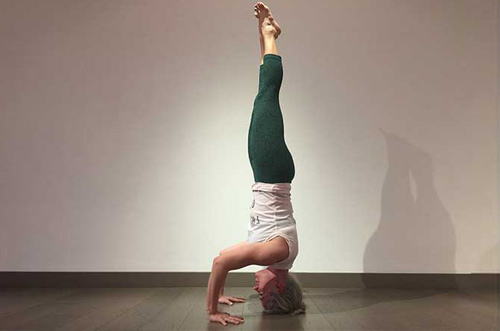
SIRHASANA (TOPSY-TURVEY POSTURE)
TECHNIQUE
Sit on your knees before a yoga mat on the floor. Interlock your fingers making the palms of your hand to assume the form of a cup. Adjust the little fingers so that both palms may rest evenly on the yoga mat. Place the hands on the mat, the little fingers touching the mat. The line joining the elbows would be the base of the triangle now formed by the position of the hands on the mat. The space between the elbows should be within the width of your chest. Next, place the crown of your head on the yoga mat so that the back of the crown touches the cupped palms. Slowly raise your knees from the Mat and keep the toes on the floor. And bring the toes of your head, and bring the toes and thighs nearer to the body.
Draw the knees close to the draw the knees close and raise both toes and legs imultaneously just try to balancebalance for a few seconds. When the balance becomes steady and the spine erect, straighten your knees and move both legs up and bring the whole body to a straight line with the head down and the feet high up. Go slowly and take a deep breathe through nose while in this posture. Retain the posture for 10 to 15 seconds to start with, and gradually increase the period to 3 minutes.
Slowly exhale and lower the legs, bending them at the knees. Draw the knees forward gradually, close to the body and let the toes touch the floor. Straighten the knees with the toes on the floor and spine straight.
Now rest both the knees on the floor and release the pose, by placing the forehead so as to rest on your closed fists placed one upon the other. Remain in this position for 30 seconds and now stand up on your legs as in Tadasana for 45 seconds. This will help to prevent a sudden reverse flow of blood from the head.
After some days of practice, when you feel ease and comfort, try to concentrate on the crown of your head with normal breathing. This Asana can be practiced according to one’s capacity and the duration may vary from one minute to three minutes for daily practice.
Note: Beginners should not stand on this pose for too long. Avoid straining the body. When you feel any sort of discomfort, return to the normal position and relax. During the practice, mentally visualize the body, keeping the knees and toes straight but relaxed. Adjust your hands in such a way that the entire weight of the body should rest only on the head, but not on the In the beginning, the sudden flow of blood into the head may cause some unusual feelings which you would gradually overcome and you would then feel comfortable. As you gain mastery, you would feel the body very light and at ease.
BENIFITS
Steady practice of Sirshasana makes the neck, stomach walls and thighs strong and powerful. The vertebral column is toned up and rendered strong. Regular practice of this Asana provide proper flow of blood through all the body cells, especially in those parts above the heart thus rejuvenating those parts. The power of thinking also increases and thoughts become more clear. The pineal and pituitary glands in the brain get proper blood supply and this ensures promotion of good health, growth and vitality. This Asana is quite beneficial to people suffering from loss of sleep, memory and vitality. Proper and correct practice of this Asana provides abundant energy and alertness. The lungs build up power to Resist changes in climatic conditions and release one of the colds, cough, tonsillitis, foul breath, palpitations, etc. It regulates the body temperature, removes constipation and tones the blood. Regular and correct practice also ensures good and healthy development of the body and mind. The power of concentration is increased.
CAUTION
Hypertension and hypotension patients and those suffering from cardiac disorders, pus in the ears, displaced retina and other chronic eye diseases should not do this Asana. Children below 15 years of age also must refrain from practicing this Asana.
